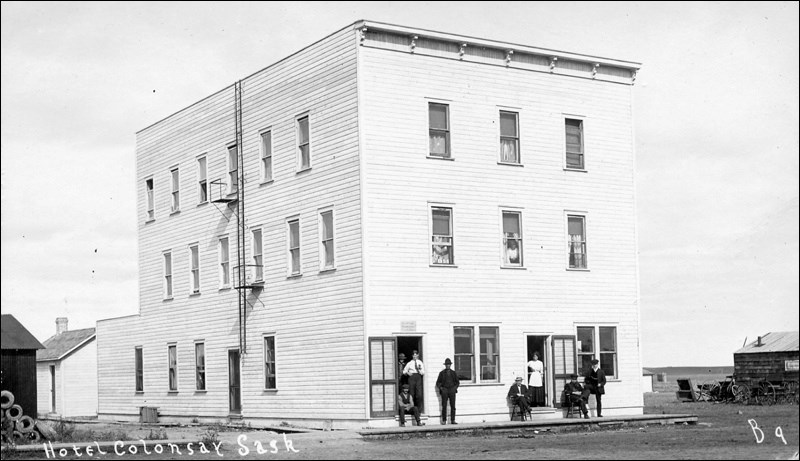The Colonsay Hotel was at the centre of a major insurance case that went all the way to the Supreme Court of Canada in the early 1920s. The court’s decision, handed down on June 15, 1923, greatly limited insurance companies’ liability on old buildings. It also became known as the “leading case” in Canadian insurance valuation cases.
Built in 1910, the 22-room hotel at Colonsay was sold two years later to John Daley for $20,000. In 1912, even though Colonsay, located 65 kilometres east of Saskatoon on Highway 16, had a population of only 150 people, optimism ran high. At that time, the bars were open, and the sale of liquor was lucrative for the hotel business.
With the advent of Prohibition in 1915, the value of the Colonsay Hotel, as with all Saskatchewan hotels, plummeted dramatically. In 1917, Daley was forced to turn the hotel was over to – ironically – the Saskatchewan Brewing Company, to which he owed $3,300.
In February 1920, Peter and Rosalina Pura, in partnership with John Lashkewicz, formed the Colonsay Hotel Company and bought the village’s hotel from the brewing company for $3,950. The Puras decided to operate a movie theatre in the hotel and had a $400 addition built. They took out insurance policies on the building and contents totalling $14,500 with three companies: the Canadian National Fire Insurance Company, the Union Insurance Society of Canton, Limited, and the British Crown Assurance Corporation, Limited.
Lashkewicz sold the Puras his half interest in the hotel property on Sept. 20, 1920. Three weeks later, on Oct. 2, 1920, the hotel was destroyed by fire. What resulted, according to newspaper reports, was a lengthy court battle between the hotel owners and the insurance companies.
The Puras had insured the hotel at a value that they believed to be the replacement value of the building – $14,500. After the fire, however, the three insurance companies offered to indemnify the Colonsay Hotel Co. for only $5,100. The owners appealed and were awarded $13,500 by the Court of King’s Bench in Saskatoon.
The insurance companies turned to the Saskatchewan Court of Appeal, claiming that the original verdict should have been based on the actual value of the hotel at the time of the fire rather than on the cost of replacing the structure. The Court of Appeal maintained the original judge’s verdict and dismissed the appeal with costs.
The insurance companies then took the case to the Supreme Court of Canada. On June 15, 1923, the five judges decided with the insurance companies, stating that the appeal should be allowed. They referred to the Saskatchewan Insurance Act, chapter 84, R.S.S. 1920, section 82 which stated that insurance companies were not liable for loss “beyond the actual value destroyed by fire.” The Supreme Court ordered a new trial and the insurance companies were eventually awarded $8,000.
According to Marvin G. Baer in his article on insurance law published in the Ottawa Law Review (Winter 1976), “Canadian National Fire Insurance Co. v. Colonsay Hotel Co.” became “the leading case” in Canada for determining actual cash value in property insurance. The unique factor in the Colonsay hotel case, Baer asserts, was the fact that the building’s depreciation in value came about not by physical deterioration, but by “obsolescence caused by external factors.” The value of a large hotel in a small town following Prohibition “is an obvious example of the kind of obsolescence which should be considered” when assessing its actual cash value.
After the ashes settled, a new, smaller hotel was built in Colonsay which still stands today.




